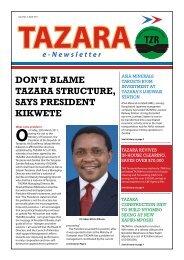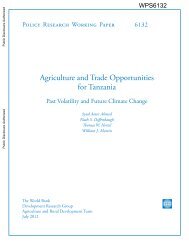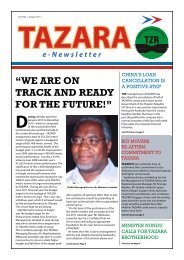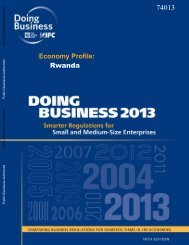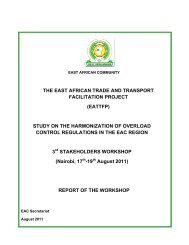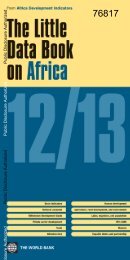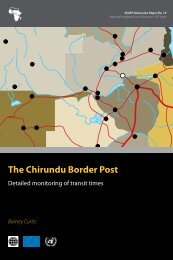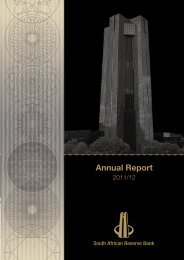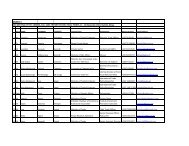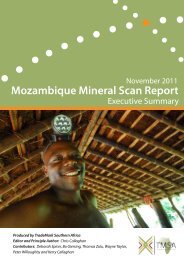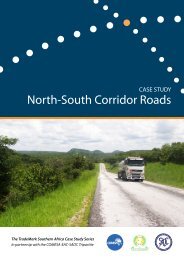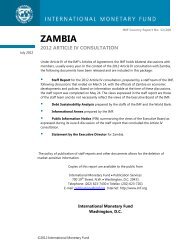Nacala Road Corridor - TradeMark Southern Africa
Nacala Road Corridor - TradeMark Southern Africa
Nacala Road Corridor - TradeMark Southern Africa
- No tags were found...
Create successful ePaper yourself
Turn your PDF publications into a flip-book with our unique Google optimized e-Paper software.
NACALA ROAD CORRIDOR PROJECT, PHASE IIZAMBIA’S COMPARATIVE SOCIO-ECONOMIC INDICATORSAppendix IYear Zambia <strong>Africa</strong>DevelopingCountriesDevelopedCountriesBasic IndicatorsArea ( '000 Km²) 753 80 976 80 976 54 658Total Population (millions) 2009 12.9 1,008 5,629 1,069Urban Population (% of Total) 2009 35.5 39.6 44.8 77.7Population Density (per Km²) 2009 17.2 3.3 66.6 23.1GNI per Capita (US $) 2008 950 1 428 2 780 39 688Labor Force Participation - Total (%) 2009 38.6 41.2 45.6 54.6Labor Force Participation - Female (%) 2009 43.2 41.2 39.8 43.3Gender -Related Development Index Value 2005 0.425 0.525 0.694 0.911Human Develop. Index (Rank among 182 countries) 2007 164 0.514 n.a n.a.Popul. Living Below $ 1 a Day (% of Population) 2004 64.3 50.8 25.0 …Demographic IndicatorsPopulation Growth Rate - Total (%) 2009 2.5 2.3 1.3 0.7Population Growth Rate - Urban (%) 2009 2.9 3.4 2.4 1.0Population < 15 years (%) 2009 46.2 56.0 29.2 17.7Population >= 65 years (%) 2009 3.0 4.5 6.0 15.3Dependency Ratio (%) 2009 97.1 78.0 52.8 49,OSex Ratio (per 100 female) 2009 99.5 100.7 934.9 948.3Female Population 15-49 years (% of totalpopulation)2009 22.1 48.5 53.3 47.2Life Expectancy at Birth - Total (years) 2009 46.4 55.7 66.9 79.8Life Expectancy at Birth - Female (years) 2009 46.9 56.8 68.9 82.7Crude Birth Rate (per 1,000) 2009 42.4 35.4 21.5 12.0Crude Death Rate (per 1,000) 2009 16.6 12.2 8.2 8.3Infant Mortality Rate (per 1,000) 2009 89.7 80.0 49.9 5.8Child Mortality Rate (per 1,000) 2009 152.0 83.9 51.4 6.3Total Fertility Rate (per woman) 2009 5.7 4.5 2.7 1.8Maternal Mortality Rate (per 100,000) 2005 830.0 683.0 440.0 10.0Women Using Contraception (%) 2005 … 61.0 75.0Health & Nutrition IndicatorsPhysicians (per 100,000 people) 2004 11.2 42.9 78.0 287.0Nurses (per 100,000 people)* 2004 168.7 120.4 98.0 782.0Births attended by Trained Health Personnel (%) 2007 46.5 50.5 63.4 99.3Access to Safe Water (% of Population) 2006 58.0 64.0 84.0 99.6Access to Health Services (% of Population) 2004 90.2 61.7 80.0 100.0Access to Sanitation (% of Population) 2006 52.0 38.5 54.6 99.8Percent. of Adults (aged 15-49) Living with HIV/AIDS 2007 15.2 4.5 1.3 0.3Incidence of Tuberculosis (per 100,000) 2007 506.0 313.7 161.9 14.1Child Immunization Against Tuberculosis (%) 2007 97.0 83.0 89.0 99.0Child Immunization Against Measles (%) 2007 97.0 74.0 81.7 92.6Underweight Children (% of children under 5 years) 2004 20.0 25.6 27.0 0.1Daily Calorie Supply per Capita 2005 1 895 2 324 2 675 3 285Public Expenditure on Health (as % of GDP) 2008 3.1 5.5 4.0 6.9Education IndicatorsGross Enrolment Ratio (%)Primary School - Total 2008 119.1 100.2 106.8 101.5Primary School - Female 2008 117.9 91.7 104.6 101.2Secondary School - Total 2008 51.8 35.1 62.3 100.3Secondary School - Female 2008 47.2 30.5 60.7 100.0Primary School Female Teaching Staff (% of Total) 2008 50.1 47.5 … …Adult Illiteracy Rate - Total (%) 2006 … 59.4 19.0 …Adult Illiteracy Rate - Male (%) 2006 … 69.8 13.4 …Adult Illiteracy Rate - Female (%) 2006 … 57.4 24.4 …Percentage of GDP Spent on Education 2008 1.4 4.5 5.4Environmental IndicatorsLand Use (Arable Land as % of Total Land Area) 2007 7.1 6.0 9.9 11.6Annual Rate of Deforestation (%) 2006 … 0.7 0.4 -0.2Annual Rate of Reforestation (%) 2006 … 10.9 … …Per Capita CO2 Emissions (metric tons) 2008 0.2 1.1 1.9 12.3Sources : ADB Statistics Department Databases; World Bank: World Development Indicators; Last update :May 2010UNAIDS; UNSD; WHO, UNICEF, WRI, UNDP; Country Reports.Note : n.a. : Not Applicable ; … : Data Not Available.




